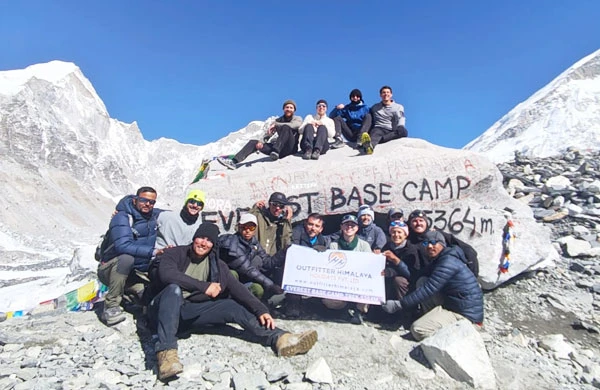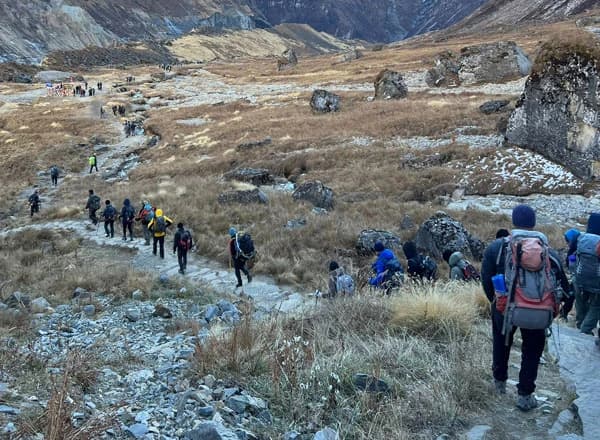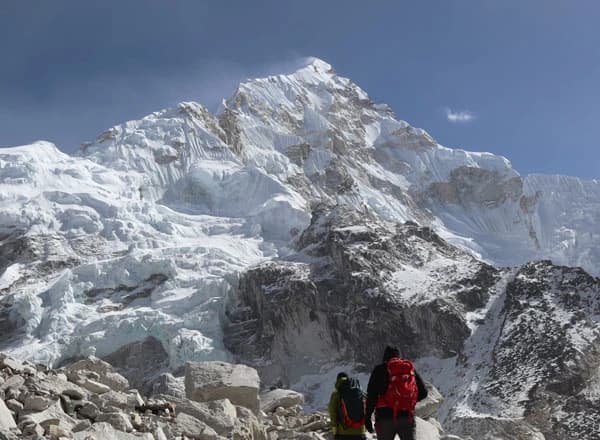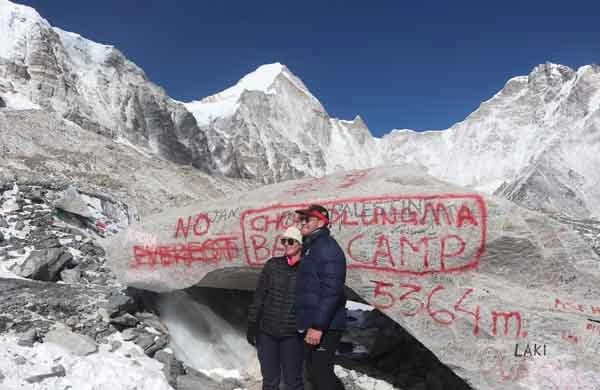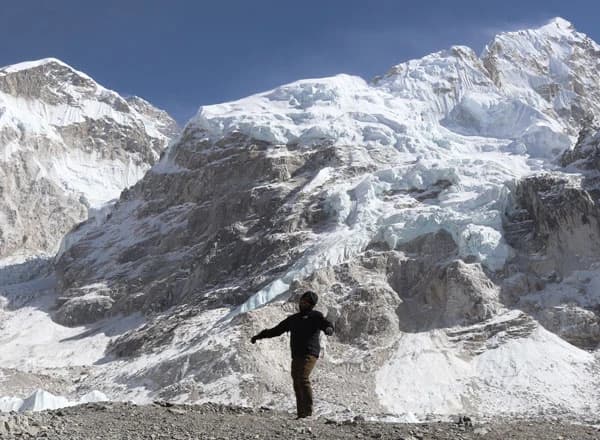Is the Everest Base Camp Trek in January doable? An expert opinion
Let's put aside the New Year's motivation for a second and answer the question: Is the Everest Base Camp trek in January doable? Frankly, January is not the preferred time for trekking in the Himalayas because of unstable weather, freezing climate, and snow-covered trails. It is the cold season, so what can you expect less?
We see people traveling to the Alps and other European countries for their vacation, spending thousands of dollars just to enjoy snow, cold, winter sports, and cozy vacations.
Instead, why not visit Nepal and have a lifetime vacation at just a fraction of the cost? Our special New Year discount makes the Everest Base Camp trek in January even more affordable. And let's not forget about the warm hospitality of the Nepali people and their welcoming and gracious spirit.
Like a cherry on top, the Everest Base Camp trek route will be empty in January because it has been a practice not to visit Everest or any part of the Himalayas to trek or hike in January. We do not agree with this practice at all. With proper preparation, packing, and dedication, you will have an incredible time trekking to Everest Base Camp in January. We are here to help you with transportation, permits, guides, porters, and other reservations.
As the New Year is also around the corner, there couldn't be a better time to book your Everest Base Camp trek for the coming January. Bookings are open. Feel free to contact us if you have any questions.
Weather and temperature
By January, it is mid of cold season. It is one of the coldest times of the year in Everest. The climate is cold throughout the day, but the warmth from the sun makes the daytime comfortable.
However, as the day falls, the temperature rapidly drops and can reach -17℃ or below in the upper part of the trail. The region experiences regular snowfall and the soundings are all covered with snow, making the landscapes extremely spectacular. The air is cold, and there may be a strong breeze on some days, so it's important to cover your face, ears, and neck. The weather remains unstable. A day can turn from bright and sunny to gloomy in no time.
There can be snow storms or heavy snowfall on some days, but it usually doesn't last more than a day. Therefore, having at least 2-3 contingency days in your itinerary is essential if you are trekking in the Himalayas in cold season. It will provide you flexibility and not stress you out. It can initially get tricky if you have not walked on snowy trails. However, you will have a grasp in just a few hours of walking.
Our guide will teach you the best ways to walk on snow without wasting your energy unnecessarily. On a good note, the sky remains clear and sunny most of the day. Still, you must pack proper clothes and protect yourself from bitter cold. Gear like trekking poles, sleeping bags, sturdy boots, etc., are crucial. Also, per the trail condition and itinerary, you may have to use crampons and a few other gears.
Below is the average temperature in January in different villages along the Everest Base Camp trail. For a detailed weather and temperature guide for the EBC trail.
- Lukla (2,846 m/9,337 ft): -2.8°C to 8.5°C
- Phakding (2,610 m/8,563 ft): 11°C
- Namche Bazaar (3,440 m/11,290 ft): -10°C to -3°C
- Tengboche (3,860 m/12,660 ft): -13°C to 1°C
- Dingboche (4,410 m/14,470 ft): -15.3°C to 1°C
- Lobuche (4,940 m/16,210 ft): -18.3°C to -1.1°C
- Gorak Shep (5,164 m/16,942 ft): -19.6°C to -2.1°C
- Everest Base Camp (5,364 m/17,598 ft): -20°C to 5°C
Everest Base Camp trek in January: Itinerary Available
The Everest Base Camp trek's 14-day itinerary is the most famous one. You will start and end the journey in Kathmandu. You will arrive in Kathmandu, have a day tour, and fly to Lukla the next day. You also have an extra day at the end of the trek as a buffer day, which we will use to fix the Lukla flight delay or cancellation.
For the Everest Base Camp trek in January, 16 to 17-day or 18-day itineraries will be ideal. You will have 2 to 4 contingency days in your hand, allowing you not to panic or stress if unseen events occur and you fall back on your plan.
Alternative treks in the Everest region in January
Why trek to Everest Base Camp in January?
Everest Base Camp Trekking in January is a personal preference. Adventurers who love the cold season will love traveling in the Himalayas in January. The Himalayan region is pretty all year, but winter brings out the true beauty of this mountain range. We have shared our top reasons for the Everest Base Camp trek in January below:
A cloudless sky- warm, comfortable daylight hours and stunning mountain vistas
The sky is cloudless on Everest, primarily in January. Some days can be gloomy, but there is nothing to worry about. While trekking, you will bask in the sun's warm rays and witness stunning mountain vistas. The daylight hours will be short but ample for enjoying the views and the journey.
Peaceful trail
One thing that peak trekking seasons lack is a peaceful trail. Thousands of trekkers do EBC treks in the spring and autumn, so the trail is not tranquil. However, not even 5% of the trekkers visit the region in January, making the EBC trail tranquil. You will have the trail to yourself, allowing you to savor every moment.
Low Lukla flight and helicopter flight cost
January is downtime for local airlines operating Lukla and regional helicopter flights. Therefore, flights are available daily. You do not have to make reservations. Likewise, the flight cost is comparatively low compared to peak seasons. If you want to experience a helicopter flight over the Himalayas, this is an excellent time because of the low helicopter flight price. The only issue is delayed flights because of unstable weather.
Ample accommodation
In months like March, April, May, September, October, and November, when the weather is the finest and hundreds of travelers visit the Everest Region, the lodges are usually all pre-booked and packed. Spending nights in dining halls is typical. However, this is not the case in January. You do not have to pre-book the lodge, and numerous options exist. Moreover, the accommodation cost is also lower than during the peak trekking months.
January festivities
January is the start of the New Year, so we are all ready to set new goals and be better versions of ourselves, which is a good enough reason to do the EBC trek in January. Likewise, we celebrate Maghe Sankranti in Nepal, which is an auspicious celebration among Nepalese.
Everest Base Camp trek in January: Major concerns
The cold climate is the primary concern when trekking to EBC in January. However, there are also a few other things to know if you plan to do the Everest Base Camp trek in January. We have also shared ways to overcome the concerns, so please read carefully.
Snowfall and trail blockade
Heavy snowfall is inevitable in January. The Everest Base Camp trail will be with thick layers of snow. The risk of cold, snowfall, and snowstorms increases as the elevation rises. The Everest base camp trekking trails in January can be hidden because of snow, and there is a high risk of getting lost if you are trekking alone. In some upper-level sections, you may also have to use crampons to walk safely on the snow. If the weather gets worse, routes like high passes get closed.
Snowstorms and bitter cold
In January, you may encounter snowstorms. Likewise, the temperature significantly drops, making the air and the climate very cold. Morning hours are calm. However, strong winds blow as the sun rises and get close to the afternoon. It is not the case every day, but you may have a tough time on some days. Therefore, we emphasize having contingency days in your itinerary.
Possibility of frostbite
Frostbite is inevitable in the cold season if you are not well dressed. It is a natural phenomenon and is 100% avoidable. We advise wearing thermal socks, gloves, and scarves to keep you warm. Likewise, you have to properly layer the clothes to fight the cold. While purchasing trekking clothes for cold temperature, ensure you get the pieces that protect you and keep you warm below -15℃.
Flight delays/getting stuck
Unpredictable weather can disrupt your itinerary. Your Lukla flight may be delayed or cancelled. Likewise, you may get stuck in a blizzard or heavy snowfall. So, having 1-2 extra days in your itinerary is important.
Slow trekking and exhaustion
Walking on snow or in cold climates demands more energy than in ideal climate conditions. You will walk slowly and also get exhausted faster than usual. Enjoy trekking to the Everest Base Camp in January requires strong fitness and patience.
Empty trails
While empty trails can be ideal for enjoying a solitary journey, they also have their side effects. You will rarely find any other fellow trekker on the way to interact with or ask for help. If you are okay with spending time alone, you will enjoy the empty trails. However, you may have to adjust if you prefer people around you. Download movies, songs, series, podcasts, etc, for the trip.
Limited menu and closed lodges
In the Himalayas, locals at higher elevations usually descend to lower elevations to spend the off season. Because of that, some lodges close. Some villagers along the Everest Base Camp trail may descend to lower altitudes to spend, but not everyone. Thanks to a low number of tourists in winter, the available open lodges are more than enough.
Similarly, the menu is limited in off season compared to peak season. You will have decent options, but the menu will have limited dishes. Carry high-energy snacks and bars.
Acclimatization
Acclimatization is an essential aspect of Everest Base Camp trekking. Cold weather makes it difficult to acclimate. You will not feel like drinking water regularly, which may dehydrate you and increase the risk of altitude sickness.
Likewise, you will also get tired sooner than usual. Therefore, trekking slowly and maintaining your pace is essential. Carry a nice water bottle that can keep your water lukewarm for a long time, and combine other fluids like electrolytes, soups, teas, etc, in your daily meals.
Should I do the Everest Base Camp trek alone or with a guide in January
We recommend trekking with a guide even during the best trekking seasons for the best experience. We suggest you trek to EBC in January with a trekking guide. In January, you will be by yourself on the trail. If you are trekking alone, no one will guide or help you unless you are in a village.
Moreover, the cold can exert additional physical and mental strain. A guide, however, will keep you motivated and ensure your safety, providing a comforting sense of security. You will have an excellent time listening to your guide's stories and talking with him. He will also help you converse with the locals, making the journey more immersive.
A guide will also help you cross the difficult sections safely and alert you in advance. We recommend trekking with a guide.
Everest Base Camp Trek in January: How to Stay Safe
Safety should be your top priority while trekking in the Himalayas in the offseason. January has many pros and cons; regardless, you must be aware of safety measures to ensure the best trip.
- Solo trekking is not encouraged. Find a reliable Nepali trekking company like Outfitter Himalaya that will arrange everything related to trekking and provide a professional guide.
- Pack proper insulating clothes for trekking in cold weather. Carry a high-quality sleeping bag that can keep you warm even below -10C.
- Make sure to have at least two acclimatization days in your itinerary.
- You should have 1-2 contingency days if you want to spend an extra night in any village or encounter an unseen situation.
- Stay informed about the weather. Check the weather forecast for the trek duration and note it if needed. Try checking the weather throughout the trip.
- Listen to your body and know when it needs to break or feel discomfort. Know the signs of altitude sickness and frostbite.
- Be aware of your surroundings and walk cautiously. Follow your guide's lead, and do not deviate from the route.
- It is crucial to be patient and flexible with the itinerary. Nothing is set in stone in the Himalayas, especially when the weather is unpredictable. Being prepared to adjust to nature's adversities can make the journey less stressful and enjoyable.
Price from
US$1300
Trek to Frozen Lake
Everest Base Camp trek in January: Price
We have many Everest Base Camp trek packages, including different trekking duration, destinations, difficulties, and services. If you follow the mainstream EBC trail (14-day itinerary), the package cost starts at USD 1400 per person and goes down as per the group size.
Our 14-day EBC trek includes two mountain acclimatization days, one full day in Kathmandu for trek preparation, and one buffer day. This itinerary is suitable and is not on a time crunch. Aside from the package cost, we recommend that trekkers withdraw money for personal expenses during trekking, such as guide and porter tips, extra food and bar bills, and to purchase additional services like hot showers, charging, WiFi, etc.
Contact us if you want to customize the Everest Base Camp trek in January package to fit your budget and requirements. We're more than happy to help.
Everest Base Camp trek in January: Packing guide
January Everest Base Camp Trek packing demands more caution and effort. You must carefully pick your base and outer layer, and packing even the smallest essentials is crucial. Below is a comprehensive list of things you need for the Everest Base Camp trek in January.
- Head and hand: Sun cap, wool/fleece hat, balaclava, neck gaiter/scarf, lightweight synthetic liner glove, wind Stopper fleece gloves/snow gloves
- Upper body: Short-sleeved shirts/t-shirts, synthetic or fleece Jacket, down insulated jacket, waterproof/windproof jacket
- Lower body: Underwear, trekking pants, synthetic insulated pants, windproof/waterproof pants, trekking & climbing socks
- First aid kit: Water purification tablets, bandage, crack bandage, tincture, Lodine, Strepsils, antibiotic, paracetamol, aspirin, Sinex, anti-diarrhea capsule/Eldoper, Brufen/ibuprofens, Diamox, eye drops, zip-lock bags
- Toiletries: Hand sanitizers, hand wash/soap, wet tissues, toothpaste, toothbrush, bath soap, shampoo, moisturizers, laundry soap, SPF, lip balm, deodorant, toilet paper
- Miscellaneous: Torch, sandals, lightweight trekking boots, daypack, duffel bag, reusable water bottle, thermos/flask, pack towel, raincoat, spare batteries, solar chargeable power bank (optional), journal/pen, book/board game, bars and snacks
- Travel documents: Valid passport (six months of validity), Nepal travel visa, PP size photo, travel insurance paper (medical and rescue), family/company contact number and address, cash, credit card
Conclusion
Whether the New Year motivates you to trek to Everest Base Camp in January or to the less crowded trails and breathtaking mountain vistas, we are here to make your wish come true. Bookings are open for 2026 and 2027 New Year departures.
Get your seat now and receive a special discount. There are many other winter treks in Nepal.
We also have shared Everest base camp trek in different months, if you are planing Everest base camp trekking for diferent month, get detail information:


